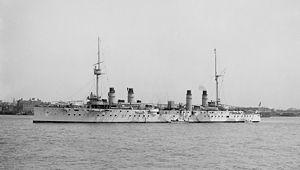 Kléber at anchor at the Jamestown Exposition, June 1907
| |
| Class overview | |
|---|---|
| Name | Dupleix class |
| Operators | |
| Preceded by | Gueydon class |
| Succeeded by | Gloire class |
| Built | 1897–1904 |
| In commission | 1904–1921 |
| Completed | 3 |
| Lost | 1 |
| Scrapped | 2 |
| General characteristics | |
| Type | Armored cruiser |
| Displacement | 7,700 t (7,578 long tons) |
| Length | 132.1 m (433 ft 5 in) (o/a) |
| Beam | 17.8 m (58 ft 5 in) |
| Draft | 7.46 m (24 ft 6 in) |
| Installed power |
|
| Propulsion | 3 shafts, 3 triple-expansion steam engines |
| Speed | 21 knots (39 km/h; 24 mph) |
| Range | 6,450 nmi (11,950 km; 7,420 mi) at 10 knots (19 km/h; 12 mph) |
| Complement |
|
| Armament |
|
| Armor | |
The Dupleix class consisted of three armored cruisers built for the French Navy (Marine Nationale) at the beginning of the 20th century. Designed for overseas service and armed with eight 164.7-millimeter (6.5 in) guns, the three ships of the class were smaller and less powerfully armed than their predecessors.
Dupleix was initially assigned to the Atlantic Division (Division de l'Atlantique) as its flagship. Her sister ships were initially assigned to the Mediterranean Squadron (Escadre de la Méditerranée), although Desaix relieved Dupleix as flagship of the Atlantic Division in 1905. Dupleix was reduced to reserve from 1906 to 1909 before she was sent to the Far East in 1910 as the flagship of the ships there. Desaix and Kléber exchanged assignments in 1907, although the former ship returned to the Atlantic in 1908 before being placed in reserve from 1909 to 1914. Kléber was also placed in reserve in 1909, but she was reactivated two years later to join Dupleix in the Far East before returning home in 1913 to be placed in reserve again.
As tensions rose shortly before the beginning of World War I in August 1914, both Desaix and Kléber were reactivated. When the war began they were assigned to defend Allied shipping in the English Channel and intercept German ships attempting to pass through. At that time, Dupleix was still in the Far East. Before she was transferred to the Eastern Mediterranean in May 1915, the ship spent most of her time on escort duty in the Indian Ocean and Red Sea. Joined by Kléber that same month, they were two of the ships tasked to blockade the Aegean coast of Ottoman Turkey. Desaix was the first of the sisters to be transferred to the Mediterranean in February 1915 and spent the next year patrolling off the coast of the Ottoman Levant and in the central Mediterranean.
To help protect Allied shipping from German commerce raiders, the sisters were transferred to French West Africa for convoy escort duties in mid-1916 and remained there for the next year. Personnel shortages caused Kléber to be ordered home in mid-1917, but she struck a naval mine laid by a German submarine in June and sank; most of her crew was rescued by ships in the area. Dupleix followed her home in October and was placed in reserve. Desaix remained in West Africa for the rest of the war.
Dupleix was decommissioned in 1919 and Desaix was transferred to the Far East that same year. After the latter's return in 1921, she was also decommissioned. Dupleix was sold for scrap in 1922 and Desaix followed five years later.